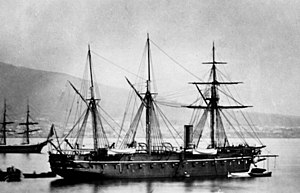Italian ironclad Principe di Carignano

Principe di Carignano in Naples in 1867
|
|
| History | |
|---|---|
|
|
|
| Name: | Principe di Carignano |
| Namesake: | Prince of Carignano |
| Laid down: | January 1861 |
| Launched: | 15 September 1863 |
| Completed: | 11 June 1865 |
| Fate: | Broken up |
| General characteristics | |
| Class and type: | Principe di Carignano-class ironclad warship |
| Displacement: |
|
| Length: | 72.98 m (239 ft 5 in) |
| Beam: | 15.10 m (49 ft 6 in) |
| Draft: | 7.18 m (23 ft 7 in) |
| Installed power: |
|
| Propulsion: | One single-expansion steam engine |
| Speed: | 10.4 knots (19.3 km/h; 12.0 mph) |
| Range: | 1,200 nmi (2,200 km) at 10 kn (19 km/h; 12 mph) |
| Complement: | 572 |
| Armament: |
|
| Armor: | Belt armor: 4.75 in (121 mm) |
Principe di Carignano was the lead ship of the Principe di Carignano class of ironclad warships built for the Italian Regia Marina in the 1860s. She was the first ironclad built in Italy; her keel was laid January 1861, her hull was launched in September 1863, and she was completed in June 1865. Principe di Carignano was a broadside ironclad armed with a battery of ten 8-inch (200 mm) guns and twelve 164-millimeter (6.5 in) guns.
Principe di Carignano saw action during the Battle of Lissa in 1866 during the Third Italian War of Independence. There, she led the Italian line, the flagship of Admiral Giovanni Vacca; the leading squadron of the Italian fleet became separated from the rest of the fleet and was not heavily engaged. Her career was limited after the war, owing to the emergence of more modern ironclads and a severe reduction in the Italian naval budget following their defeat at Lissa. The ship was stricken from the naval register in 1875 and broken up for scrap to free up funds needed for new ironclads under construction.
Principe di Carignano was 72.98 meters (239.4 ft) long between perpendiculars; she had a beam of 15.1 m (50 ft) and an average draft of 7.18 m (23.6 ft). She displaced 3,446 metric tons (3,392 long tons) normally and up to 3,912 t (3,850 long tons) at full load. She had a crew of 572. Her propulsion system consisted of one single-expansion steam engine that drove a single screw propeller, with steam supplied by four coal-fired, rectangular fire-tube boilers. Her engine produced a top speed of 10.4 knots (19.3 km/h; 12.0 mph) from 1,968 indicated horsepower (1,468 kW). She could steam for about 1,200 nautical miles (2,200 km; 1,400 mi) at a speed of 10 knots (19 km/h; 12 mph). To supplement her steam engine, the ship was barquentine-rigged.
...
Wikipedia
